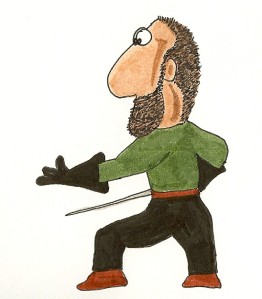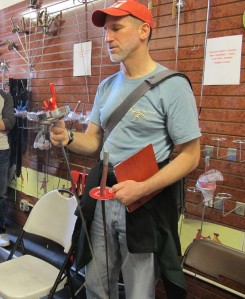V is for Varvarinski
Today could be about the volte (evasion from opponents blade by moving the back foot to the right (for righty) or left (for lefty) displacing the body away from the line of attack and creating a new attack line for yourself)… but it’s not. Voltes are cool. But so is Varvarinski.
Nikolai Varvarinski is a fencing master in my book, Open Wounds. Here’s how he describes his philosophy of fencing to the protagonist, Cid Wymann:
“In war I lose count. It is what happen in war.”
“How many in duels?”
“In first duel I place my point in other boy’s chest”— he pointed to the center of his chest—“here. Into heart, I think. Blade go into body—go into body far. I let go of blade—stare at boy. He stare back at me but does not die. I think, why does boy not die? While I think, he put blade in my side and almost kill me.” He lifted up his shirt and showed me a thick puckered scar above his hip.
“You don’t remember?”
“There are many things I not remember.”
“What happened to your fencing school?”
He did not answer for a while, then his hand trembled a moment and he clenched it into a fist. “Enough talk. Now back to work!”
R is for Remise
Remise…
is one of my favorite fencing terms.
It means to attack and attack again. If your first attack misses or is blocked you do not retreat or recover. You attack again without pause. That is a remise.
It requires great confidence and nerve, sometimes leg strength for a double or triple lunge. If you pause after missing the first time and hesitate, even for a second, you lose the initiative. The remise is finished. So don’t pause. Keep going forward and attacking until you touch your point to his chest (or wrist, or arm, or head, or, or, or…). It is thrilling to do and a bit frightening to have done to you.
To defend against the remise you retreat, parry, stop thrust, or some combination of these three in order to stop the juggernaut. Cut into his attack. Get out of distance. Make him pause and hesitate, so that you can take the initiative from him.
My books original title was Remise. My publisher said it had to be changed. “It is a French word,” she said. “Nobody will know what it means.”
Open Wounds is more brutal but Remise is elegant violence.
Here’s my main character, Cid Wymann learning about the remise from his old Russian fencing master, Nikolai Varvarinksi.
->—
Open Wounds, by Joseph Lunievicz, Chapter 17
->—
“Aldo Nadi says—”
“I am not Nadi,” Varvarinksi shouted and threw his glove onto the ground. “You want to take lesson from Nadi you find Nadi!”
“I didn’t mean—”
“Kónchit’! No more questions. You learn. I teach! Remise is attack, then attack.”
“What do you mean?” We had been working on parry-riposté drills, Nikolai pushing me to parry later and later, and to riposté faster and faster.
Nikolai picked up his glove and épée. He cinched his leather wrist strap tight and secured the grip against his palm. “With foil you extend arm before attack. Da?”
I nodded and rolled my eyes, having heard his explanation of foil what seemed like a thousand times before.
“Good,” he said, ignoring me. “You know difference between foil and épée?”
“Yes, yes,” I said, nodding and mouthing the words with him.
“If you parry, I withdraw arm, extend again before I attack in redoublement,” he said, showing me with his blade in quick, sharply etched movements.
“That sounds French,” I said.
“Quiet!” he shouted and launched an attack at my chest so quickly I barely had time to parry. Only instead of relaxing his arm back into en garde he kept his arm extended and attacked again to my hip. I stumbled back just in time to parry his strike in seconde and retreated again, now off balance, parrying another attack to my shoulder in sixte, only the third time I was too slow and his point touched my upper arm. Nikolai didn’t stop. His momentum threw him forward and pushed his point into my flesh. I tripped over my feet and fell to the ground. My arm felt as though it had been pierced.
“Remise!” he said, looking down at me, anger seething out of his lips.
“Remise,” I repeated, my own anger building in return. I touched the bruised skin of my arm. There was some blood where the point had hit. It was sore and would be black and blue in the morning. “Remise,” I said again, quietly. The world slowed down and my senses expanded. I heard the rasping sound of gravel shifting beneath Nikolai’s front foot and the dull thudding of my heart. His breath was ragged. A high-pitched buzzing floated by one of my ears and passed around to the other.
It seemed impossible for such a large and out-of-shape man to move that fast. In drills he pushed me with his own attacks, but they were timed and rhythmic, beautiful in their own way and mesmerizing in their patterns, but never blinding in speed. I’d thought he was fast enough to touch me only if I made a mistake. Now, watching him walk awkwardly away from me, his shoulders slumping forward, his belly hanging again over his pants, my anger grew. “Why don’t you try that again?” I said, the words seeming to elongate out in front of me as if in a dream.
Nikolai stopped in his tracks, then turned to face me. “You want to fight me?” His words were crisp, dangerous.
“Yes,” I said.
->— Open Wounds, by Joseph Lunievicz
E is for Épée
 There are three competitive weapons in fencing today: foil, sabre, and épée. I have fenced épée on and off for over thirty years (more off than on, and with a tremendous amount of humility), tried sabre for a year or two and started with foil as most fencers do. The question is what’s the difference and why should you care?
There are three competitive weapons in fencing today: foil, sabre, and épée. I have fenced épée on and off for over thirty years (more off than on, and with a tremendous amount of humility), tried sabre for a year or two and started with foil as most fencers do. The question is what’s the difference and why should you care?
I’ll tell you. The first cover of my book – the one that went on my ARC – was a dark, edgy image of a fencer in mask and full uniform. I loved it. Only one thing. It was a sabre fencer and my protagonist, Cid Wymann, fenced épée. I got another, better cover, with an image of a stage rapier super-imposed over NYC. Each is a different weapon with a different personality and type of fencer who picks it up.
This is important. Each weapon speaks to character and personality.
Foil is more structured and formal with a rule called right of way which dictates who can score and who can’t. You must extend your arm fully to take the attack. It makes foil more structured and in some ways artificial – more of a sport than a martial art. The target is only the torso, not the arms, legs, pelvis, or head. The blade is thin and bends. It can even be used in a whipping motion to score back hits in a move that has nothing to do with the martial art (hits over the shoulder and into the back?) of the sword. You can only score with the point.
Sabre is a holdover from rapier and calvary sabre days. It is an agressive and sometimes brutal sport (okay, okay, if you parry well you can avoid getting hit which is the idea. I get wacked because I’m slow with my parries). You can get bruised up because the thin metal blade is used to both cut (both sides are considered to be edged) and thrust (it has a point also). There is a guard to cover the hand and you need it. It uses the same right of ways rules as foil and is hard to follow because it is so fast. The target is the waist up but not the hands so the arms and head come into play and must be defended. Sabre moves fast and furiously. Sometimes you see sparks fly from blade contact.
I learned to fence with a foil my first two years fencing. I learned to be agressive with sabre. I learned to think with épée. That’s my story and I’m sticking with it.
C is for Capo Ferro
Capo Ferro has not nothing to do with Italian food or stringed instruments.

It, or rather he, has everything to do with what we know about actual rapier, rapier and dagger, and sword and buckler (shield) fighting from the renaissance period. Since we don’t have film from back then and no photographs, we have to go by line drawings and any books that were written that described it like the one above from Capo Ferro’s book Italian Rapier Combat originally published in 1610. I bought my copy in Portland from Powell’s Books (awesome indi and just a huge huge store). This book is a series of plates with short explanations of the positions and moves of Italian rapier fencing. The Italians were known in the 16th into the early 17th century to be the best with the sword. The French surpass them later but not for a long long time. Ferro was a fencing master in the city of Siena. My favorite are the many images that show (see below) what happens when you are successful in attack. Notice the three different angles the blade can take and the successful parry with the dagger.

Of course this is 1610 Italy so most people in the plates are fencing naked or mostly naked (very strategically placed scraps of cloth or leaf)- not sure I’d recommend that – must have been very hot in Siena.
Here are some words from the first section: Some Remembrances or True Advices of Fencing
First, if you are found at blows with your adversary; you must always have the eye on the sword hand more than in other places, all of the others are false, because looking at the hand you will see the stillness and all the movements that it does, and from this (according to your judgement) you will be able to determine what you will have to do.
Methods that one must hold against a brutal man:
If you have to encounter a brutal man who, without misura and tempo, hurls many blows at you with great impetus, you will be able to do two things. First adopt the interplay of mezzo tempo, as I will teach you in its place, you will strike him in his hurling of the point, either by cut in the hand or in the sword arm. Otherwise, you can leave him to proceed at emptiness with somewhat voiding the vita backwards, and then you instantly drive a point into the face or chest.
Needless to say, I chose Capo Ferro as a model teacher for my protagonist in my novel Open Wounds.
How could I not?
A is for Actors On Guard
 Actors On Guard, by Dale Anthony Girard – a great book on the use of the rapier and dagger for stage and screen.
Actors On Guard, by Dale Anthony Girard – a great book on the use of the rapier and dagger for stage and screen.
A young man, a kid really, is doing choreography with a rapier, musketeer blade (double wide épée), cup hilt. He does the choreography well with his partner, an experienced actor and stage combat veteran named Dave. Dave is waiting for the kid to start his schtick.
“What’s the real thing like?”
So it begins.
“I bet I could hold my own in a fight with one of these.” The kid’s looking at the blade with confidence.
“Sure you could,” Dave says. He’s tired from almost three hours of fencing choreography – two classes, a beginner’s class and an advanced. This is the advanced class. He’s sweating and perspiring. He worked all night at his seventeen-year proofreading job, graveyard shift. He won’t go to sleep until that evening – if he can last. Its been 24 hours since he slept.
“Seriously, Dave,” the kid says. “Why won’t Joe fence against me?”
“Just stick with the choreography.”
“I bet I could fence against you.” The kid thrusts his blade tip at Dave’s chest.
Dave bats it away with his hand – his leather gloved hand. He’s more awake now. “You’re not a fencer,” he says with just a bit of an edge. “You’re an actor.”
“I’m pretty good,” the kid’s bouncing on the balls of his feet. “I could fence.”
“Joe,” Dave shouts and turns away from the kid. “Kid wants to see what it’s like to fence.”
An older man, probably in his seventies – the decades speaking in the lines of his face – rouses himself from reading the paper at the teacher’s desk. He slaps the newspaper shut and stands up, pushing his chair back. “David,” he shouts back. The rest of the class stops their work on the days choreography to see what’s happening. “Get the kid suited up.” He smooths back his white hair with his fingers and walks over to a locker, pulls out his gear. Dave gets the kid suited up with fencing jacket, mask, glove, competitive sabre. The old man suits up in similar whites. His fits loosely, like he used to fill it out more. Still he wears it with familiarity. He walks past the kid with his helmut under his arm. He turns smartly. Dave has pushed the rest of the class back so they’re all against the wall – out of range. All except the kid. Dave’s put him in the center with the old man.
“We’ll do three touches,” the old man says. “Dave, you’ll judge.” Dave nods and the old man salutes him, the kid, and the audience, then puts on his mask. The kid, a huge smile on his face, copies him.
“Fencers ready?” Dave asks.
The old man nods and says, “Yes, sir.” He is still. His sabre in the line of three.
Dave repeats his question to the kid. The kid is nervously swaying back and forth, the blade moving from side to side.
“Fencers ready? Dave asks him a third time.
He nods finally.
Before the kid can take a step forward the old man slashes his sabre’s edge across his chest. The kid stumbles back a step clutching his chest with his free hand. He rubs it smartly.
Dave hears him breathing shallowly. He knows that one hurt, even with a canvas jacket on.
“Fencers ready?”
The old man cuts the kids arm and the kid grabs the place where he was hit.
“You ok?” Dave asks sweetly.
The kid nods.
Third go.
The old man waits this time. He drops his guard down, inviting the kid in to an open target. The kid attacks. He cuts to the old man’s head. The old man parries easily in five and smacks the kid hard in the head, hard enough to make him stagger back a step and to make the rest of the class gasp.
The old man swipes off his helmut and throws it to Dave. “Carry on,” he says and retreats back to his desk where his paper waits for him.
Dave directs the others to go back to their choreography. He walks up to the kid. “Ready for choreography?” he asks.
The kid nods. He’s still wearing his mask. He still hasn’t moved.
For the A-Z challenge I’ll be talking sword-play, every letter of the alphabet. I love to fence and I love to do the choreography of stage fencing. Outside of playing rugby there’s just about nothing better. As a writer who’s first book has more fencing and stage combat in it than most I hope this unique expertise can help others figure out how to write about the use of the sword whether it’s a small sword, a foil, a broadsword, a bastard sword, or a rapier and dagger. Maybe it’ll help with your next fantasy novel or historical. If you have questions, ask. Otherwise onward tomorrow to B.









